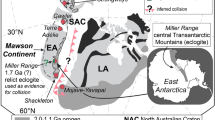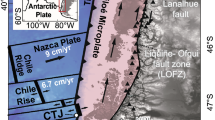Abstract
Kent and Opdyke1 have argued that during the late Devonian and early Carboniferous, the eastern part of the northern Appalachians (Acadia) was situated ∼1,500 km further south relative to cratonic North America than it is at present, and that it moved to its present position sometime later in the Carboniferous (Fig. 1). Van der Voo and Scotese2 proposed an even greater displacement of 2,000 km which they attribute to motion between cratonic North America and Europe, Acadia being attached to Europe (Fig. 1). The argument is that palaeolatitudes (λp) derived palaeomagnetically from Upper Devonian and Lower Carboniferous rocks of cratonic North America are 15–20° more northerly than those of Acadia and Europe. The proposed shear zone passes through central Newfoundland. Using palaeomagnetic results from eastern and western Newfoundland we show here that no such motion occurred. We also show that Kiaman (late Carboniferous and Permian) overprinting is widespread in Newfoundland, and that these secondary magnetizations agree (with two exceptions attributed to dextral rotation of the Colorado Pleateau) with observations from late Devonian and early Carboniferous rocks of the North American craton, confirming the proposal3 that magnetizations of the cratonic early Carboniferous rocks are Kiaman, not early Carboniferous in age. Our results also enable us to extend this proposal3 to late Devonian rocks of the craton. Hence the palaeolatitudinal offset of Fig. 1 is almost certainly not tectonic, but is an artefact of the wrong assumption of the equivalence of rock and magnetization ages.
This is a preview of subscription content, access via your institution
Access options
Subscribe to this journal
Receive 51 print issues and online access
$199.00 per year
only $3.90 per issue
Buy this article
- Purchase on Springer Link
- Instant access to full article PDF
Prices may be subject to local taxes which are calculated during checkout
Similar content being viewed by others
References
Kent, D. V. and Opdyke, N. D. J. geophys. Res. 83, 4441–4450 (1978).
van der Voo, R. & Scotese, C. Geology 9, 583–589 (1981).
Roy, J. L. & Morris, W. A. Earth planet. Sci. Lett. 65, 167–181 (1983).
Creer, K. M. Nature 219, 246–250 (1968).
Irving, E. & Parry, L. G. Geophys. J. R. Astr. Soc. 7, 395–411 (1963).
Köppen, W. & Wegener, A. Die Klimate der geolischen Vorseit (Borntrager, Berlin, 1924).
Hedley, I. G. Phys. Earth planet. Inter. 1, 103–121 (1968).
Hodych, J. P., Patzold, R. R. & Buchan, K. L. Can. J. Earth Sci. 21, 127–130 (1984).
Chamalaun, F. & Creer, K. M. J. geophys. 69, 1607–1616 (1964).
Irving, E. & Opdyke, N. D. Geophys. J. R. astr. Soc. 9, 153–167 (1965).
Roy, J. L., Opdyke, N. D. & Irving, E. J. geophys. Res. 72, 5075–5086 (1967).
Irving, E. & Strong, D. F. Earth planet. Sci. Lett. (in the press).
Irving, E. & Strong, D. F. J. geophys. Res. (in the press).
Irving, E. & Pullaiah, G. Earth Sci. Rev. 12, 35–64 (1976).
Knowles, R. P. & Opdyke, D. N. J. geophys. Res. 73, 6515–6526 (1968).
Kent, D. V. J. geophys, Res. 84, 3576–3588 (1979).
van der Voo, R. Geology 7, 297–298 (1979).
Strong, D. F. & Irving, E. Abstr. Geol. Ass. Can. (Newfoundland Branch, 1983).
Hiscott, R. & Coniglio, M. Geosci. Can. 10, 123–125 (1983).
Gall, Q. thesis, Memorial Univ. Newfoundland (1983).
Kent, D. V. J. geophys. Res. 87, 8709–8716 (1982).
van der Voo, R., French, A. N. & French, R. B. Geology 7, 345–348 (1979).
Arthaud, F. & Matte, P. Bull. geol. Soc. Am. 88, 1305–1320 (1977).
Morris, W. A. Can. J. Earth Sci. 13, 1236–1243 (1976).
Kent, D. V. & Opdyke, N. D. EOS 65, 200 (1984).
Kent, D. V. & Opdyke, N. D. Earth planet. Sci. Lett. 44, 365–372 (1979).
Martin, D. L. Tectonophysics 28, 125–134 (1975).
Elston, D. P. & Bressler, S. L. Earth planet. Sci. Lett. 36, 423–433 (1977).
Scott, G. R. J. geophys. Res. 84, 6277–6285 (1979).
Irving, E. & Irving, G. A. Geophys. Surv. 5, 141–188 (1982).
Wynne, P. J., Irving, E & Osadetz, K. Tectonophysics 100, 241–256 (1983).
Author information
Authors and Affiliations
Rights and permissions
About this article
Cite this article
Irving, E., Strong, D. Evidence against large-scale Carboniferous strike-slip faulting in the Appalachian–Caledonian orogen. Nature 310, 762–764 (1984). https://doi.org/10.1038/310762a0
Received:
Accepted:
Issue Date:
DOI: https://doi.org/10.1038/310762a0
Comments
By submitting a comment you agree to abide by our Terms and Community Guidelines. If you find something abusive or that does not comply with our terms or guidelines please flag it as inappropriate.



